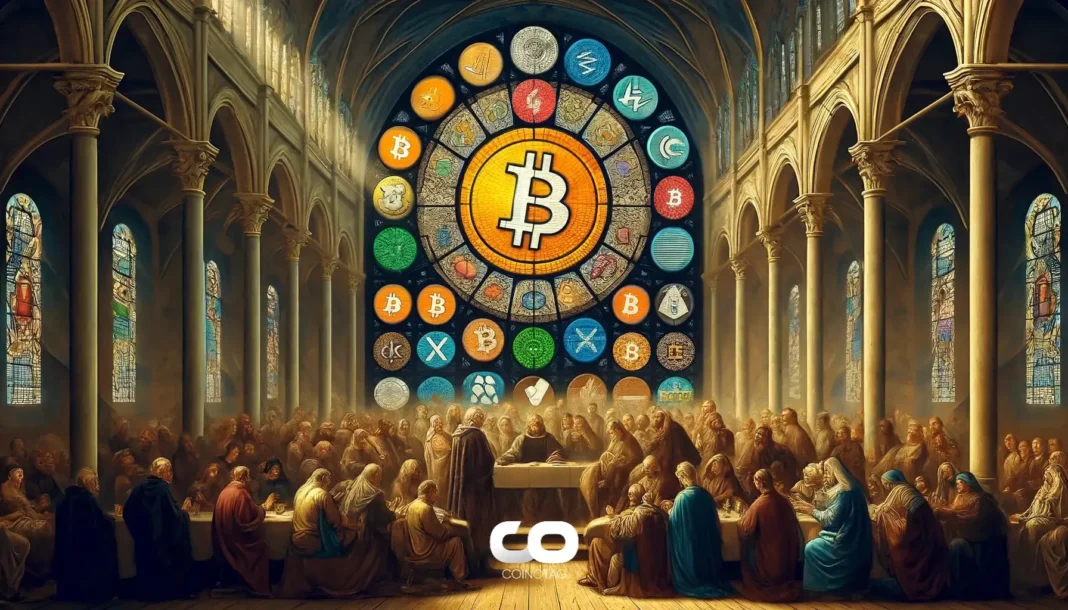| COINOTAG recommends • Exchange signup |
| 💹 Trade with pro tools |
| Fast execution, robust charts, clean risk controls. |
| 👉 Open account → |
| COINOTAG recommends • Exchange signup |
| 🚀 Smooth orders, clear control |
| Advanced order types and market depth in one view. |
| 👉 Create account → |
| COINOTAG recommends • Exchange signup |
| 📈 Clarity in volatile markets |
| Plan entries & exits, manage positions with discipline. |
| 👉 Sign up → |
| COINOTAG recommends • Exchange signup |
| ⚡ Speed, depth, reliability |
| Execute confidently when timing matters. |
| 👉 Open account → |
| COINOTAG recommends • Exchange signup |
| 🧭 A focused workflow for traders |
| Alerts, watchlists, and a repeatable process. |
| 👉 Get started → |
| COINOTAG recommends • Exchange signup |
| ✅ Data‑driven decisions |
| Focus on process—not noise. |
| 👉 Sign up → |
-
Concerns surrounding Binance’s token listing criteria have escalated following the recent volatility of the Test (TST) token, which experienced a dramatic market cap surge driven by social media momentum.
-
The TST token, initially intended for educational purposes on the BNB Chain, was propelled to a peak valuation of nearly $500 million before witnessing a steep downturn, raising questions about listing practices at major exchanges.
-
As stated by Yi He, Binance’s co-founder, the exchange’s listing standards encompass ROI, innovation potential, and buzz around high-profile projects, underscoring the complexities of token reception in the market.
This article explores the recent fluctuations in Binance’s list criterion amid the TST token’s brief surge to a $489 million market cap, raising critical investor concerns.
Regulatory Compliance Amidst Listing Controversies
In the face of rapid market changes, regulatory compliance has become a cornerstone of Binance’s operations. Yi He highlighted that Binance has strict guidelines to ensure compliance and integrity within the platform. Notably, internal investigations have led to the dismissal of 60 employees based on over 120 cases of misconduct.
While most violations did not pertain to insider trading, He stated that issues such as accepting bribes and transferring company assets to personal wallets were prevalent. “We take these actions seriously and have pursued legal recourse where necessary,” He affirmed, emphasizing Binance’s commitment to uphold its integrity.
Implications of Decentralized Exchange Trading
As transactions on decentralized exchanges (DEXs) gain momentum among sophisticated traders, the impact on centralized exchange (CEX) dynamics cannot be understated. Following TST’s listing, many DEX traders quickly sold their assets, contributing to the volatility observed in the token’s price post-listing. This pattern has raised alarms regarding how effectively exchanges can navigate and incorporate DEX metrics into their listing strategies.
| COINOTAG recommends • Professional traders group |
| 💎 Join a professional trading community |
| Work with senior traders, research‑backed setups, and risk‑first frameworks. |
| 👉 Join the group → |
| COINOTAG recommends • Professional traders group |
| 📊 Transparent performance, real process |
| Spot strategies with documented months of triple‑digit runs during strong trends; futures plans use defined R:R and sizing. |
| 👉 Get access → |
| COINOTAG recommends • Professional traders group |
| 🧭 Research → Plan → Execute |
| Daily levels, watchlists, and post‑trade reviews to build consistency. |
| 👉 Join now → |
| COINOTAG recommends • Professional traders group |
| 🛡️ Risk comes first |
| Sizing methods, invalidation rules, and R‑multiples baked into every plan. |
| 👉 Start today → |
| COINOTAG recommends • Professional traders group |
| 🧠 Learn the “why” behind each trade |
| Live breakdowns, playbooks, and framework‑first education. |
| 👉 Join the group → |
| COINOTAG recommends • Professional traders group |
| 🚀 Insider • APEX • INNER CIRCLE |
| Choose the depth you need—tools, coaching, and member rooms. |
| 👉 Explore tiers → |
Changpeng Zhao, the former CEO, remarked that the CEX listing process needs adjustments, particularly in light of new trading strategies employed by investors taking advantage of arbitrage opportunities. The interactivity between DEXs and CEXs illustrates a growing challenge for established players like Binance.
TST Token’s Volatility: A Case Study in Speculation
The TST token’s rapid ascent to a market capitalization of $489 million led many to question the criteria behind token listings on Binance. Originally intended for demonstration within a BNB Chain tutorial, the TST token gained traction when it was inadvertently promoted by Chinese influencer communities, creating significant buzz despite being mischaracterized as a meme.
| COINOTAG recommends • Exchange signup |
| 📈 Clear interface, precise orders |
| Sharp entries & exits with actionable alerts. |
| 👉 Create free account → |
| COINOTAG recommends • Exchange signup |
| 🧠 Smarter tools. Better decisions. |
| Depth analytics and risk features in one view. |
| 👉 Sign up → |
| COINOTAG recommends • Exchange signup |
| 🎯 Take control of entries & exits |
| Set alerts, define stops, execute consistently. |
| 👉 Open account → |
| COINOTAG recommends • Exchange signup |
| 🛠️ From idea to execution |
| Turn setups into plans with practical order types. |
| 👉 Join now → |
| COINOTAG recommends • Exchange signup |
| 📋 Trade your plan |
| Watchlists and routing that support focus. |
| 👉 Get started → |
| COINOTAG recommends • Exchange signup |
| 📊 Precision without the noise |
| Data‑first workflows for active traders. |
| 👉 Sign up → |
Though Binance’s Yi He clarified that the tutorial video was not an endorsement, the notion of accidental hype generation highlights the sometimes unpredictable nature of token listings and market reactions. Furthermore, the subsequent fall in TST’s market cap, plunging over 50% shortly after its peak, serves as a cautionary example for investors navigating this volatile crypto landscape.
Investor Sentiment and Market Dynamics
Investor behavior surrounding the TST token illustrates a larger trend of fickle sentiment in cryptocurrency markets. The initial excitement over the TST token was fueled by hype, yet its sharp decline reflects the susceptibility of meme coins to rapid market sentiment shifts. This phenomenon raises significant questions about investor strategies and the sustainability of hype-driven tokens.
| COINOTAG recommends • Traders club |
| ⚡ Futures with discipline |
| Defined R:R, pre‑set invalidation, execution checklists. |
| 👉 Join the club → |
| COINOTAG recommends • Traders club |
| 🎯 Spot strategies that compound |
| Momentum & accumulation frameworks managed with clear risk. |
| 👉 Get access → |
| COINOTAG recommends • Traders club |
| 🏛️ APEX tier for serious traders |
| Deep dives, analyst Q&A, and accountability sprints. |
| 👉 Explore APEX → |
| COINOTAG recommends • Traders club |
| 📈 Real‑time market structure |
| Key levels, liquidity zones, and actionable context. |
| 👉 Join now → |
| COINOTAG recommends • Traders club |
| 🔔 Smart alerts, not noise |
| Context‑rich notifications tied to plans and risk—never hype. |
| 👉 Get access → |
| COINOTAG recommends • Traders club |
| 🤝 Peer review & coaching |
| Hands‑on feedback that sharpens execution and risk control. |
| 👉 Join the club → |
Conclusion
In summary, the saga of the TST token underscores the complexities and risks associated with cryptocurrency listings. As Binance navigates regulatory scrutiny and investor sentiment fluctuations, understanding the nuanced criteria behind token listings will be crucial for both exchange operators and investors. Moving forward, enhanced transparency and clearer guidelines may help mitigate risks for investors and uphold market integrity.
| COINOTAG recommends • Members‑only research |
| 📌 Curated setups, clearly explained |
| Entry, invalidation, targets, and R:R defined before execution. |
| 👉 Get access → |
| COINOTAG recommends • Members‑only research |
| 🧠 Data‑led decision making |
| Technical + flow + context synthesized into actionable plans. |
| 👉 Join now → |
| COINOTAG recommends • Members‑only research |
| 🧱 Consistency over hype |
| Repeatable rules, realistic expectations, and a calmer mindset. |
| 👉 Get access → |
| COINOTAG recommends • Members‑only research |
| 🕒 Patience is an edge |
| Wait for confirmation and manage risk with checklists. |
| 👉 Join now → |
| COINOTAG recommends • Members‑only research |
| 💼 Professional mentorship |
| Guidance from seasoned traders and structured feedback loops. |
| 👉 Get access → |
| COINOTAG recommends • Members‑only research |
| 🧮 Track • Review • Improve |
| Documented PnL tracking and post‑mortems to accelerate learning. |
| 👉 Join now → |







